| کد مقاله | کد نشریه | سال انتشار | مقاله انگلیسی | نسخه تمام متن |
|---|---|---|---|---|
| 6404497 | 1330904 | 2014 | 5 صفحه PDF | دانلود رایگان |
- We developed a novel data analysis method for flow cytometry (FCM).
- FCM and aerobic plate count (APC) were performed on Escherichia coli spiked green tea.
- FCM data were analyzed by conventional counting and multivariate analysis (MVA).
- Conventional FCM showed coefficient of determination (R2) of 0.916 with APC.
- MVA showed much better APC prediction accuracy with R2 of 0.982.
Flow cytometry (FCM) and aerobic plate count (APC) by the culture method were performed on green tea samples spiked with Escherichia coli type strain NCTC9001 (ATCC11775) solutions of different concentrations. In FCM, fluorescence signals from multiple stained bacteria and other fluorophores are detected using detector channels, and recorded as events with a voltage at each channel. FCM data were analyzed in two ways: conventional and multivariate analysis. In the former, the number of events with voltages larger than the defined threshold values was regarded as the predicted APC. In the latter, voltage histograms of all channels were obtained and merged horizontally to serve as explanatory variables. Then a partial least squares regression (PLSR) model was built to predict APC from the histogram data. The coefficient of determination (R2) and the root mean square error (RMSE) between APC by the culture method and that predicted by conventional FCM were 0.916 and 1.08Â cfu/ml2. The APC values predicted by the PLSR model and those measured were in good agreement with R2 of 0.982 and RMSE of 0.417Â cfu/ml, which verified the potential of the proposed method for improving APC prediction accuracy by FCM.
Journal: LWT - Food Science and Technology - Volume 55, Issue 2, March 2014, Pages 472-476
